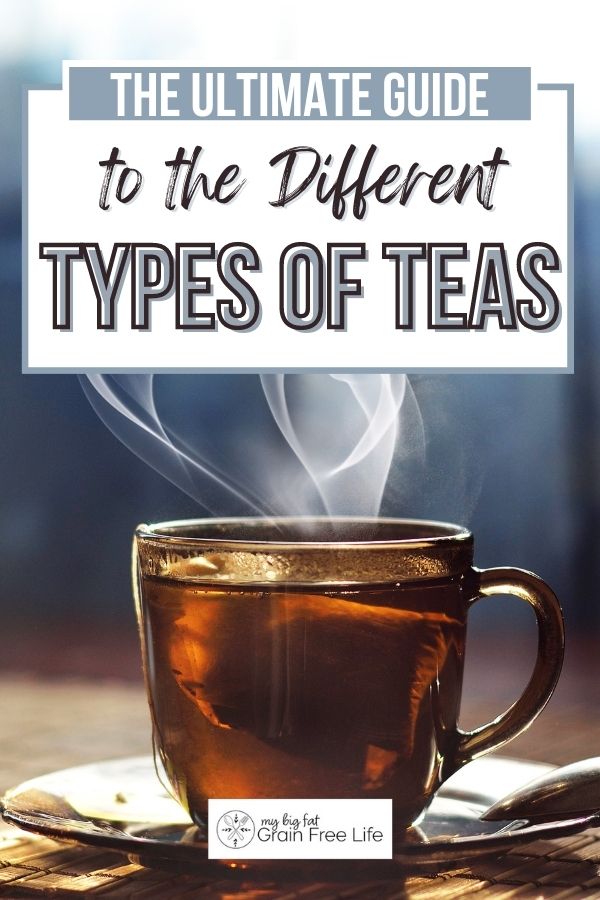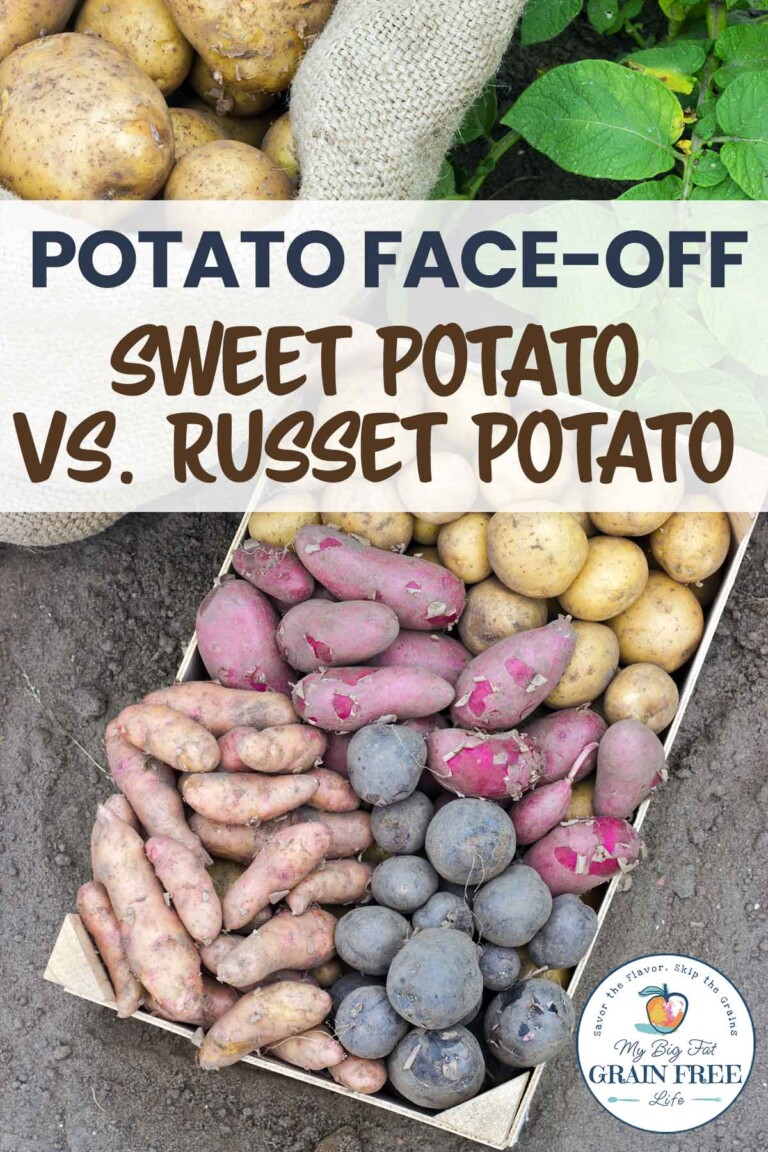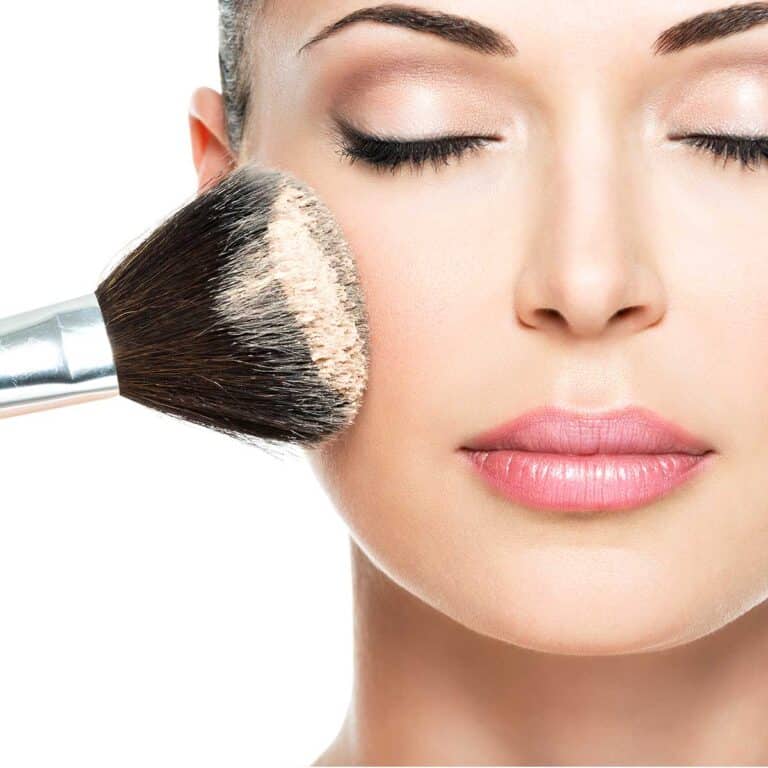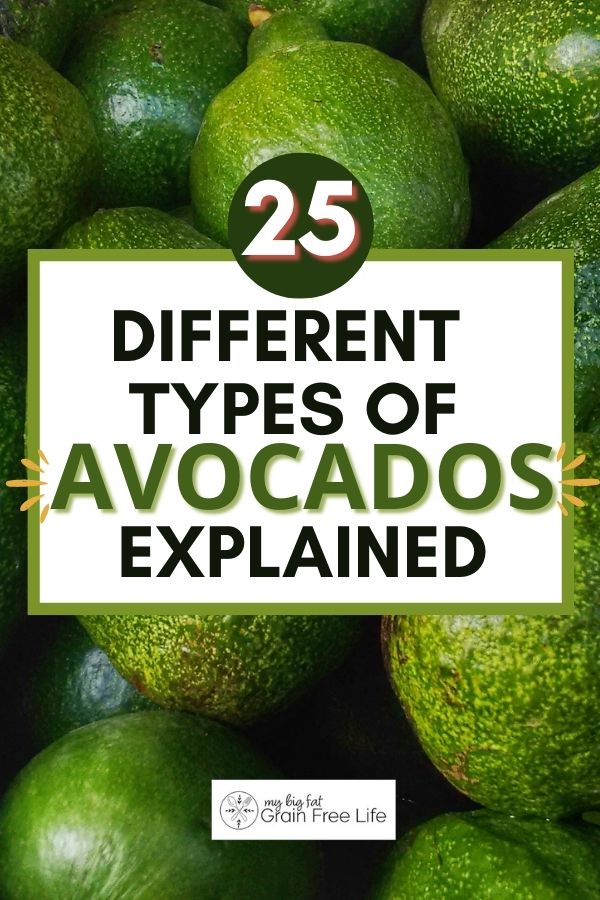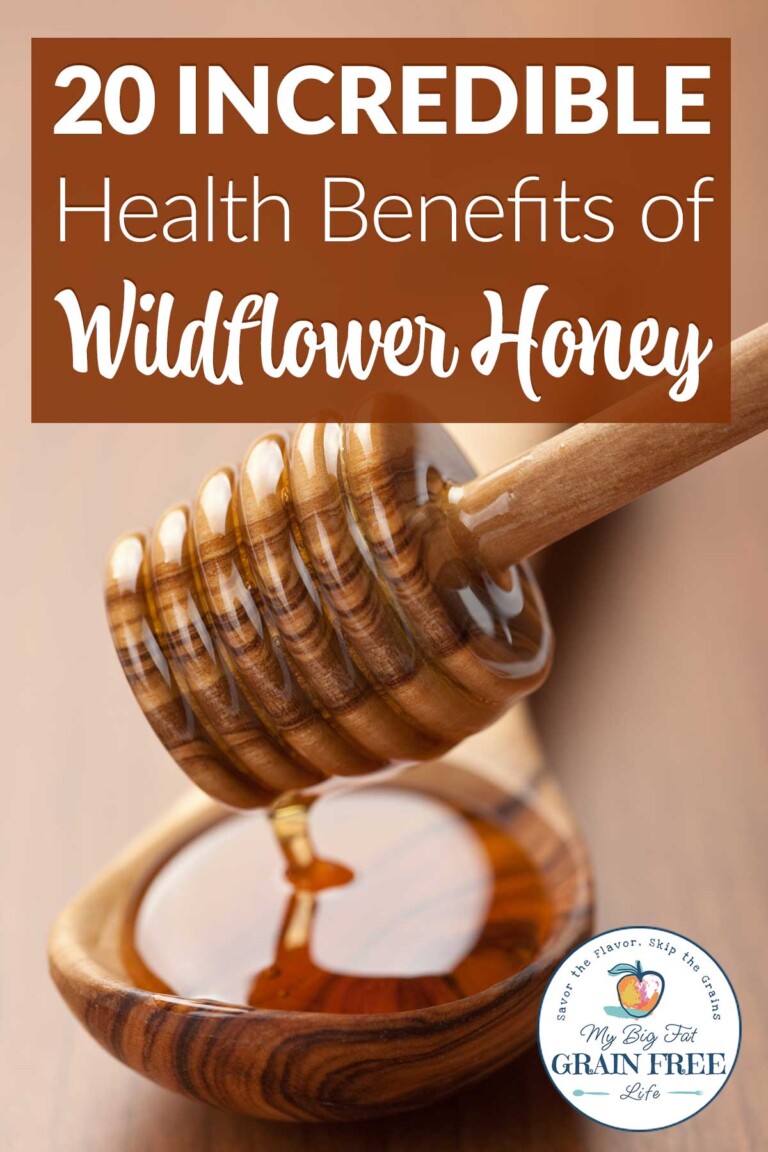The Ultimate Guide to The Different Types of Tea
This post may contain affiliate links. If you make purchase after clicking a link, I may receive a commission at no extra cost to you.
Last Updated on June 16, 2023
Tea drinkers around the world know there’s nothing like a cup of good tea. However, there are many different types of tea that people drink. These include the most popular types of tea, such as black tea, green tea, and herbal tea. In addition, there are many other types of tea you can enjoy. Let’s take a look!
Types of Tea
If you are a tea drinker or are interested in learning about some of the benefits of drinking tea, it’s good to learn about the many different types of tea. Did you know there are thousands of different types of tea?
First, let’s learn a bit more about tea, and then we will take a look at some of the most popular types of tea.
What is tea?
True tea is a beverage that’s made by pouring water over cured or fresh leaves of the Camellia sinensis plant. It’s an evergreen shrub that’s native to East Asia and used to make white, green, yellow, red, black, and oolong teas.
You will also hear people refer to herbal infusions and blends as teas. However, they are not considered true tea. Instead, they’re made from various leaves, roots, barks, and flowers of edible plants other than the camellia sinensis or tea plant.
Herbal teas, such as ginger tea, have many health benefits.
Also check out: Best Teas for Sinus Infections & The Best Tea for Candida
Tea Plant: Camellia Sinensis
The tea plant Camellia sinensis produces different types of tea. The plant is a sub-tropical shrub that’s native to East Asia. It’s currently grown all around the world.
The best plants grow at higher elevations on steep slopes. This requires the leaves to be hand-picked.
Tea plants that are grown for large-scale commercial operations are planted on flat lowlands. This allows machinery to be used to harvest the leaves.
If you enjoy coffee too, you might also enjoy: How to Make Coffee Alkaline
Different Types of Tea
In this article we will go over all the different types of tea, how it’s made, where it comes from, health benefits, and the different types of tea within each main category.
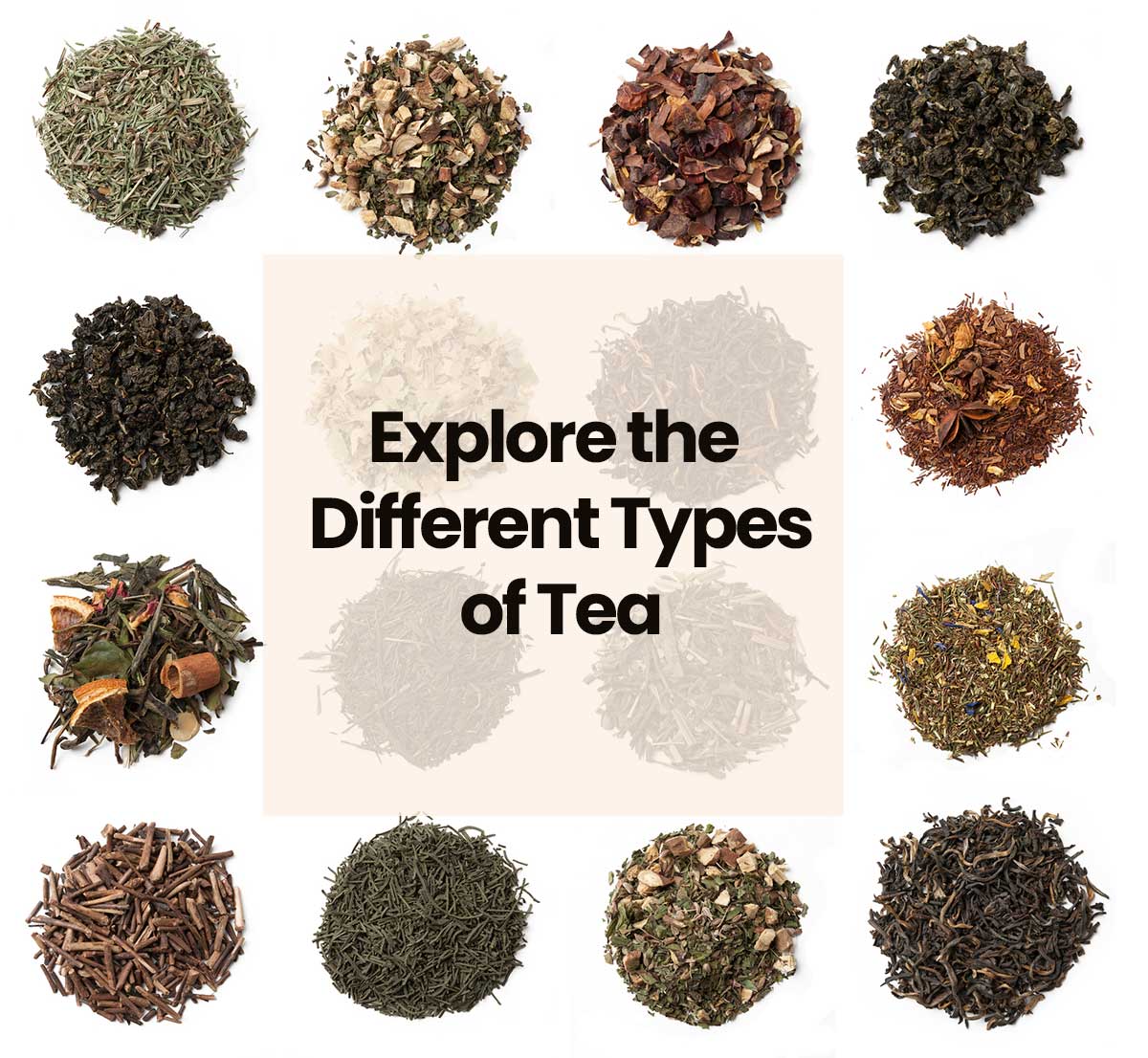
Black Tea
Black tea has a stronger flavor than other true teas. It’s made by steeping black tea leaves in water and is drunk both hot and cold. It’s relatively high in its caffeine content.
How Black Tea is Made
Black tea comes from two varieties of the tea plant: Camellia sinensis and Camellia sinensis assamica. The fresh tea leaves are harvested. Then they are wilted and crushed before beginning the oxidation process.
During the oxidation process, the leaves are exposed to air and turn brown. Once they’re oxidized to the correct level, the tea is fixed. Fixing the leaves means they’re heated to stop the oxidation process.
Where Black Tea Comes From
Most black tea comes from China and India. However, it’s also made in Sri Lanka, Vietnam, Nepal, and Kenya.
Health Benefits of Black Tea
Black tea includes antioxidant properties that may help reduce the risk of cancer as well as flavonoids such as quercetin. Other health benefits include the possibility of improved heart health, gut health, and the ability to focus. In addition, black tea may lower your risk of stroke and blood sugar.
Is Black Tea Caffinated?
Yes, black tea is caffeinated.
Types of Black Tea
- Assam
- Ceylon
- Chai
- Darjeeling
- Earl Grey
- English Breakfast
- Golden Tips
- Irish Breakfast
- Keemun
- Lapsang Souchong
- Milima
- Nimbu
- Panyang Congou
- Pu-Erh
- Rukeri
- Scottish Afternoon
- Temi Sikkim
- Wakuocha
Black tea is often used to make kombucha. Lots of people drink kombucha for weight loss, gut health, and for an immunity boost!

Green Tea
Green tea is another one of the main types of tea that’s drunk around the world. You’ll find different varieties of tea that, include Japanese green teas and Chinese green teas. The manufacturing process is different from that of black tea.
Just like fruit infused water, adding some fruit to your green tea will result in added nutrients and a flavorful kick.
How Green Tea is Made
Green tea leaves include the leaf buds and the first leaf or two underneath them. The leaves are usually harvested in the spring and early summer. Once harvested, the leaves are quickly exposed to heat to prevent oxidation from happening, allowing the young leaves to keep their green color.
The leaves are then rolled, shaped, and dried before being sorted by size.
Where Green Tea Comes From
Green tea is manufactured all over the world. You’ll find it manufactured in places like Hawaii and South Carolina in addition to China, Japan, and India.
Health Benefits of Green Tea
There are several health benefits associated with drinking green tea. For instance, it may improve your cognition, help with weight loss, and lower the risk of developing cancer.
Is Green Tea Caffinated?
Yes, green tea is caffeinated, although it has less caffeine than black tea.
Types of Green Tea
- Anji Bai Cha
- Bancha
- Bi Luo Chun
- Chun Lu
- Chun Mee
- Daejak
- Genmaicha
- Gunpowder
- Gyokuro
- Hojicha
- Jasmine
- Jin Shan
- Jungjak
- Kabusecha
- Kamairicha
- Konacha
- Kukicha
- Longjing (Dragon Well)
- Maofeng
- Maojian
- Matcha
- Mecha
- Sejak
- Sencha
- Shincha
- Taiping Houkui
- Tamaryokucha
- Tencha
- Ujeon
- Yellow

White Tea
If you’re looking for a cup of tea that doesn’t include much caffeine and has a delicate floral flavor, then you need to try white tea. White tea gets its name from the white hairs left on the leaves after harvesting.
How White Tea is Made
White tea’s drying process begins by being left in direct sunlight before being taken inside for more withering. The leaves are then heated to fix them and prevent oxidation. The next step is to roll or crush the leaves and then allow them to fully dry.
Where White Tea Comes From
White tea comes from the Fujian Provence of China and is only harvested for a couple of weeks in the spring.
Health Benefits of White Tea
White tea contains a high number of antioxidants that help to fight free radicals in your body. It also may help weight loss, improve your heart, and protect your teeth. It’s also associated with a reduced risk of Parkinson’s disease and Alzheimer’s.
Is White Tea Caffinated?
Yes, white tea comes from the tea plant and contains caffeine. It is estimated that a cup of white tea has 15% less caffeine than a cup of green tea.
Types of White Tea
- Darjeeling White
- Gong Mei
- Shou Mei
- Silver Needle
- White Peony

Purple Tea
Purple tea is a new tea that was developed in Kenya. Anthocyanin is present in the plant. This is the same compound that gives blueberries their color. The presence of Anthocyanin is what gives the purple tea leaves their color.
How Purple Tea is Made
Purple tea is made through a similar process to green tea. The leaves are heated indoors to prevent them from oxidizing. Then the leaves are rolled before being shaped and dried.
Where Purple Tea Comes From
Purple tea comes from Kenya.
Health Benefits of Purple Tea
Drinking purple tea may help make you more resistant to common colds and sore throats due to its anti-inflammatory and anti-viral properties. It also has more antioxidants which help you reduce your risk of cancer.
Is Purple Tea Caffinated?
Yes, purple tea has a small amount of caffeine in it.
Types of Purple Tea
- Kenyan Purple Leaf
- Sun Rouge
- Ye Sheng
- Zi Juan
- Zi Ya
Oolong Tea
Oolong tea is another type of tea made from camellia sinensis leaves. It’s oxidized longer than green teas but not as long as black teas.
How Oolong Tea is Made
The tea leaves are harvested when they’re about half-grown. The leaves are laid out in the sun for a time before they’re bruised.
Bruising is a process by which the leaves are shaken in a basket, and people press on the leaves with their hands. The bruising process helps to remove the moisture content and grassiness from the tea.
The leaves are then heated to stop the oxidation process before being rolled into the appropriate shape. Then the oolong tea leaves are baked one last time before being sorted and packed.
Where Oolong Tea Comes From
The popular tea originated in China. Today, the best oolong teas tend to come from either China or Taiwan.
Health Benefits of Oolong Tea
Oolong tea has several health benefits, including a decreased risk of diabetes due to the polyphenols in the tea. Polyphenols may also help your heart. Oolong may also prevent cognitive decline and assist in weight management.
Is Oolong Tea Caffinated?
Yes, oolong tea is caffeinated.
Types of Oolong Tea
- Alishan
- Ancient Tree Dan Cong
- Bai Jiguan
- Cassia
- Da Hong Pao
- Da Yu Lin
- Dancong
- Dong Ding
- Dong Fang Meiren
- Guan Yin
- Jin Xuan
- Li Shan
- Mi Lan Xiang Dan Con
- Pouchong
- Ruan Zhi
- Shui Jin Gui
- Shui Xian
- Tie Luo Han
- Tieguanyin (Iron Goddess)
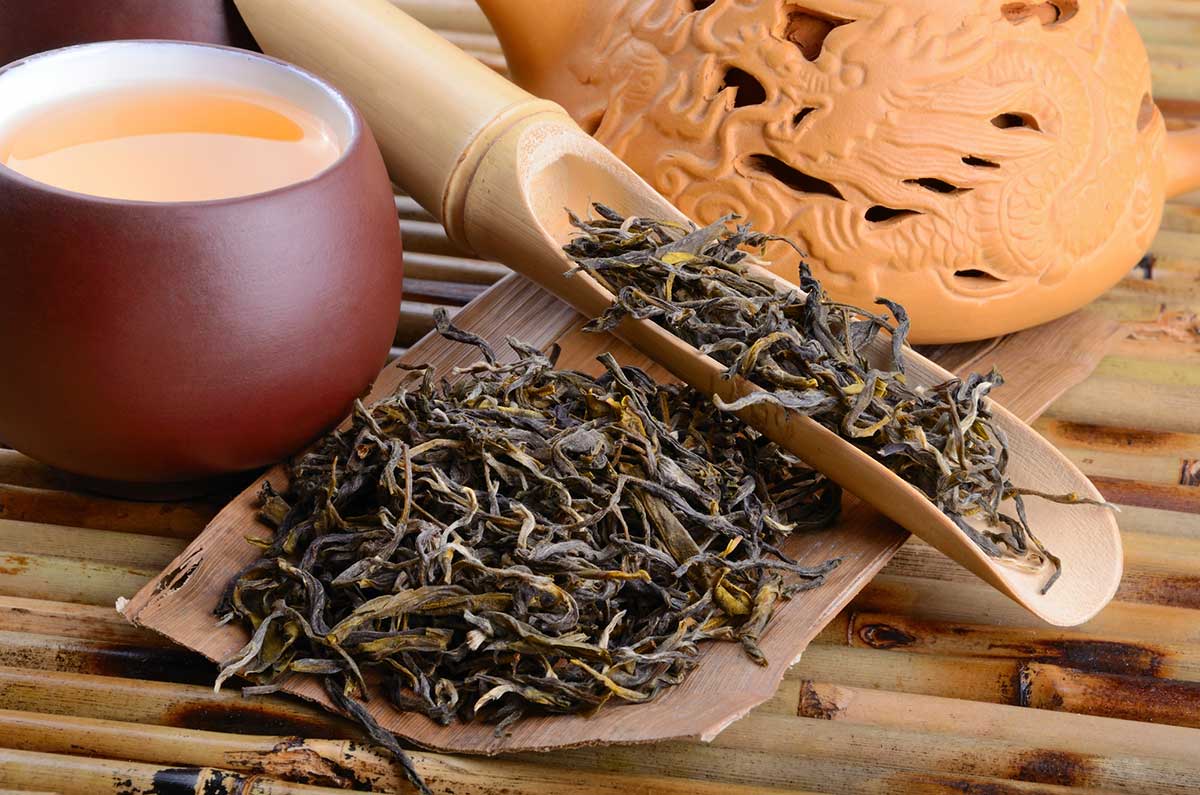
Pu-erh Tea
Pu-erh tea is a Chinese tea from the Yunnan province. The tea has a rich flavor.
How Pu-erh Tea is Made
Two types of pu-erh tea are manufactured: raw pu-erh and ripe pu-erh. Raw pu-erh is made by harvesting green tea leaves. It’s then roasted, sun-dried, and steamed before being packed into cakes and balls. The tea continues to age for a time. Raw pu-erh has a bright yellow color after it’s brewed.
Ripe pu-erh starts with the same process as the raw pu-erh until it’s ready to be packed into cakes and balls. At this point, the tea leaves are stacked into piles and sprayed with water. The stacks are then covered with a linen cloth. The brewed ripe pu-erh tea is usually a dark amber color.
Where Pu-erh Tea Comes From
Pu-erh tea usually comes from Taiwan or southwest China.
Health Benefits of Pu-erh Tea
Some of the health benefits of pu-erh tea are the diverse number of bacteria it contains that improve gut health. It also helps with weight loss and improves the health of your heart.
Is Pu-erh Tea Caffinated?
Yes, Pu-erh tea is caffeinated.
Types of Pu-erh Tea
- Raw Pu-erh
- Ripe Pu-erh
Learn more about fermented teas below.

Yellow Tea
Yellow tea is a rare tea that’s micro-fermented as part of the manufacturing process.
How Yellow Tea is Made
Yellow tea has a similar processing style to green tea. It’s harvested from the tea plant and exposed to heat. Then it’s rolled and dried. However, as part of the drying process, yellow tea is allowed to ferment slightly, giving it a mellow flavor distinct from green tea.
Where Yellow Tea Comes From
Yellow tea comes from the mountains in China. Specifically, the high mountains in the Hunan, Zhejiang, Anhui, and Sichuan provinces.
Health Benefits of Yellow Tea
Drinking yellow tea offers health benefits like delayed aging. It may help your body regulate its metabolism and bad cholesterol. It may also improve your dental health.
Is Yellow Tea Tea Caffinated?
Yes, yellow tea is caffeinated. However, a cup of yellow tea has less caffeine than a cup of coffee.
Types of Yellow Tea
- Jun Shan Yin Zhen
- Meng Ding Huang Ya
- Huo Shan Huang Ya
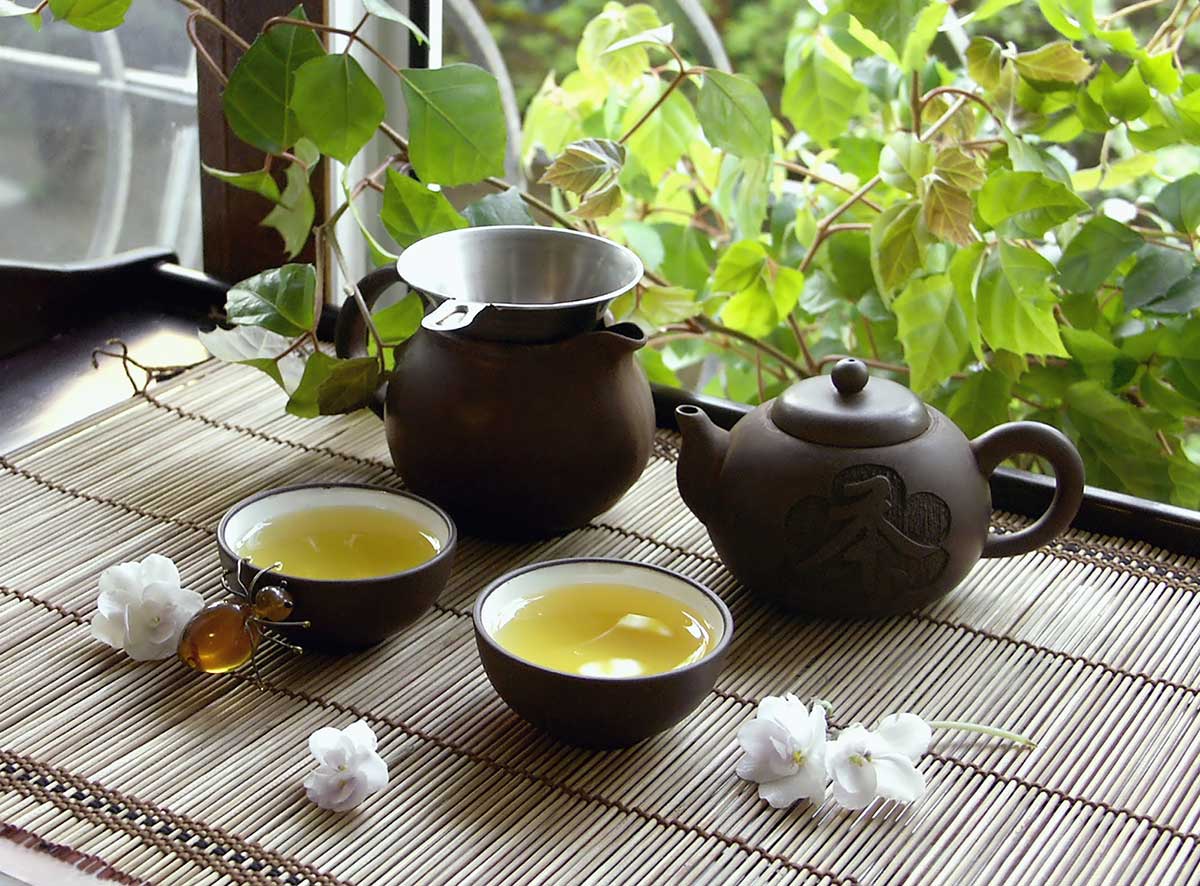
Matcha Tea
Matcha tea has a rich and more intense flavor. It’s made by grinding high-grade green tea into powder. The tea is whisked into hot water instead of being steeped, which makes it a frothy tea for people to drink.
How Matcha Tea is Made
The smallest two leaves of the tea plant are harvested to make matcha tea. They are then steamed to prevent the leaves from oxidizing before being dried. The tea leaves are then refrigerated until they’re ready to be ground into a fine powder.
Where Matcha Comes From
Matcha tea originally comes from Japan, although it’s now grown and manufactured around the world.
Health Benefits of Matcha
Matcha is high in antioxidants which may help to prevent cell damage and decrease your risk of cancer. It may also help to protect your liver while improving brain function.
Is Matcha Tea Caffinated?
Yes, matcha tea is caffeinated.
Types of Matcha Tea
- Ceremonial
- Culinary
- Ingredient
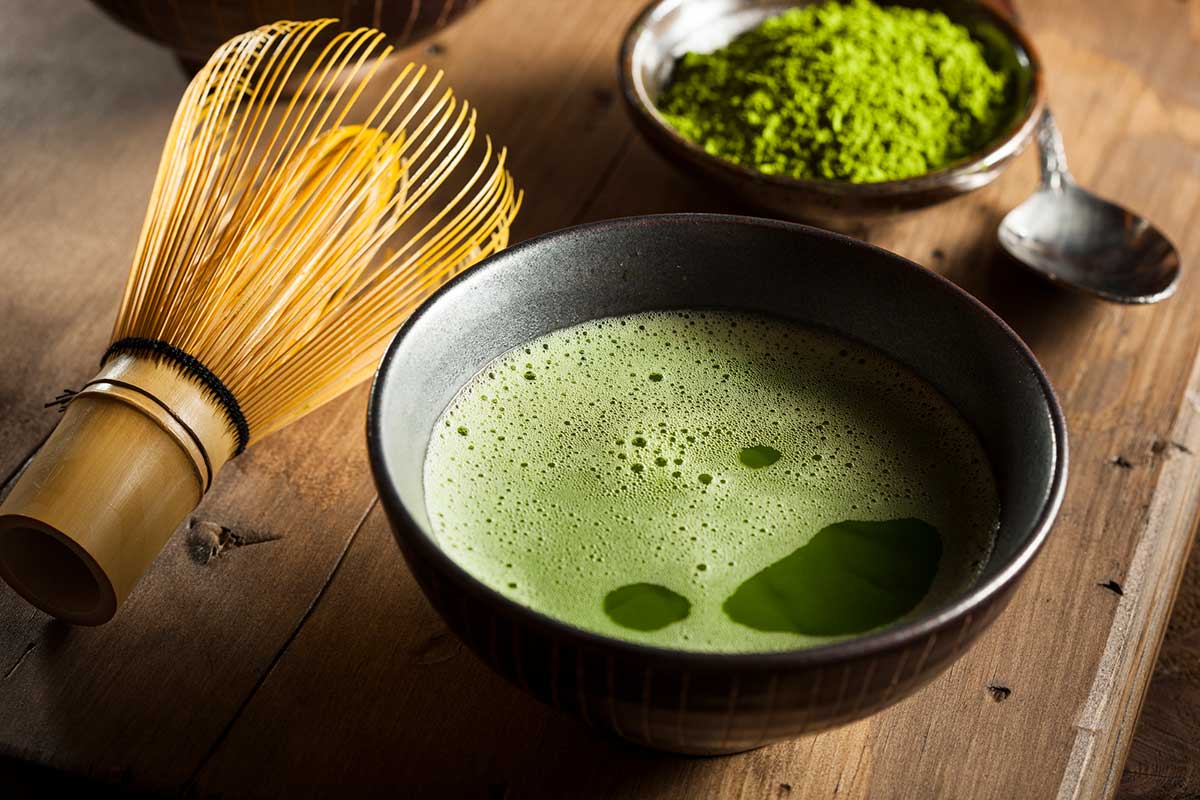
Chai Tea
Chai tea is a type of black tea that usually has spices, sweeteners, and milk added to it. Assam tea is the type of black tea most commonly used to create chai tea.
How Chai Tea is Made
Chai tea is made by taking black tea and mixing it with spices like cinnamon, cloves, and ginger. The chai tea is then brewed with milk before being sweetened with sugar or honey.
Where Chai Tea Comes From
Chai tea originated in India and is now enjoyed worldwide.
Health Benefits of Chai Tea
Drinking chai tea may provide many health benefits, including being good for your teeth and helping to prevent colds. It’s also full of antioxidants which may help you prevent cancer and cell damage. Chai tea may also improve the health of your heart and digestion.
Is Chai Tea Caffinated?
Yes, chai tea is caffeinated.
Types of Chai Tea
- Bombay Chai
- Butter Tea
- Cardamom Chai
- Ginger Chai
- Irani Chai
- Kangra Chai
- Kashmiri Kahwa
- Lebu Chai
- Lemongrass Chai
- Masala Chai
- Nilgiri Tea
- Noon Chai
- Ronga Saah
- Sulaimani Chai
- Tulsi Chai
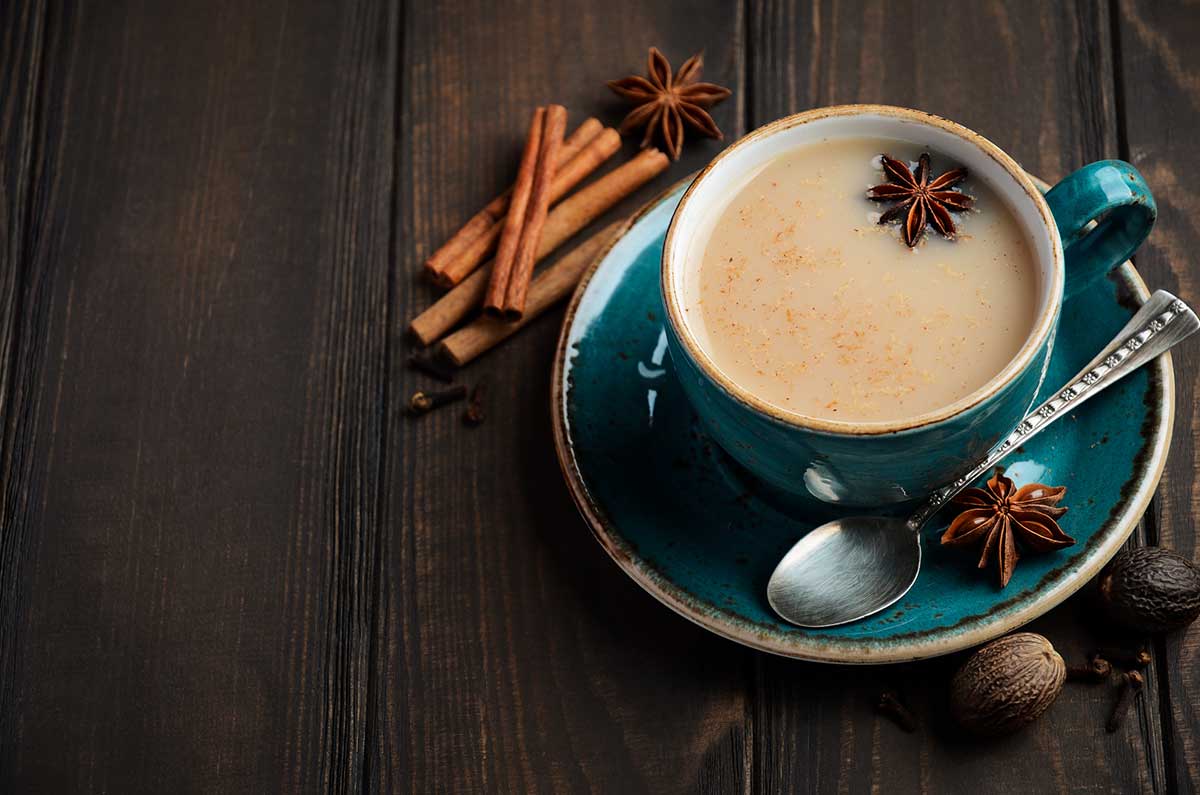
Rooibos Tea
Rooibos tea is not a true tea that comes from the camellia sinensis plant. Instead, it’s an herbal tea that comes from an African shrub called Aspalathus linearis.
How Rooibos Tea is Made
The leaves of the shrub are harvested and fermented, which causes the leaves to become a reddish-brown color. Green rooibos is made from the same leaves, but the leaves are not fermented, leaving them a green color.
Where Rooibos Tea Comes From
Rooibos tea comes from the West Cape province of South Africa.
Health Benefits of Rooibos Tea
Rooibos tea is low in tannins which may prevent your body from absorbing some nutrients. It’s also packed with antioxidants that might help to prevent cancer and cell damage. It may also improve the health of your heart.
Is Rooibos Tea Caffinated?
No, rooibos tea does not contain caffeine.
Types of Rooibos Tea
- Green Rooibos Tea
- Red Rooibos Tea
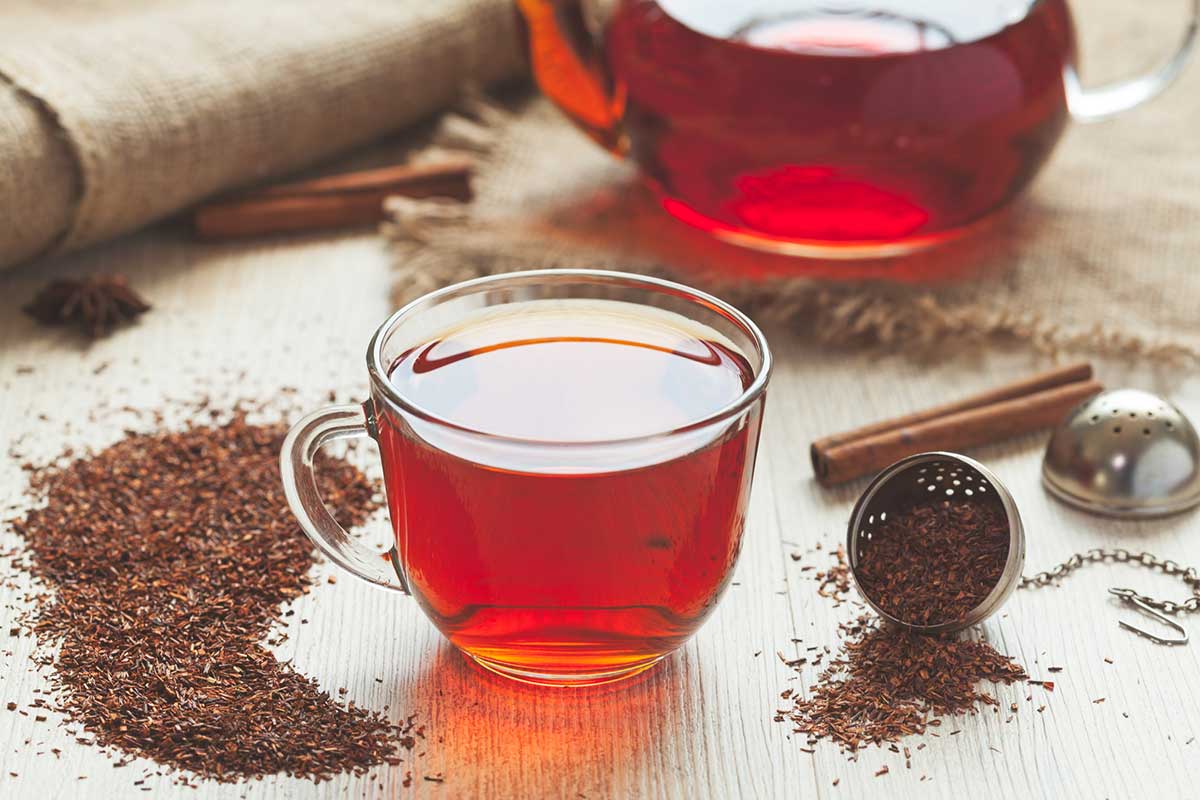
Holly Teas
Holly teas come from a family of holly plants. These teas include a high amount of caffeine and have a flavor similar to that of green tea.
How Holly Teas Are Made
Holly tea is made by picking the leaves of the holly bush before washing them. The leaves are then roasted until they’re brown and crispy. The leaves are then ground.
Make holly tea by allowing the ground leaves to steep for 5-10 minutes in hot water.
Where Hollies Tea Comes From
Holly tea comes from North and South America.
Health Benefits of Holly Tea
You may find that holly tea offers several health benefits when you drink it, like having more energy and better brain function. It’s also a good source of polyphenols that may reduce your risk of cancer.
Are Holly Teas Caffinated?
Yes, Holly teas are caffeinated.
Types of Holly Tea
- Yerba Mate
- Guayusa
- Yaupon
Yerba Mate Tea
Yerba mate tea is a tea made from the leaves and twigs of the Ilex paraguariensis plant. The plant is a member of the Holly family and is native to South America. It’s strong, bitter, and has a distinct taste.
How Yerba Mate Tea is Made
Yerba mate tea is an herbal tea that’s made by drying and grinding the leaves. The leaves are then steeped in hot water.
Where Yerba Mate Tea Comes From
Yerba mate tea originally came from Paraguay and then spread to other areas of South America.
Health Benefits of Yerba Mate Tea
Yerba mate tea is full of antioxidants that may reduce your risk of cancer and cell damage. In addition, drinking yerba mate tea may help you lose weight and reduce the amount of bad cholesterol in your body.
Are Yerba Mate Teas Caffinated?
Yes, yerba mate teas are caffeinated.
Types of Yerba Mate Tea
- Argentinian Yerba Mate
- Paraguayan Yerba Mate
- Uruguayan Yerba Mate
- Brazilian Erva Mate (Chimarrão)
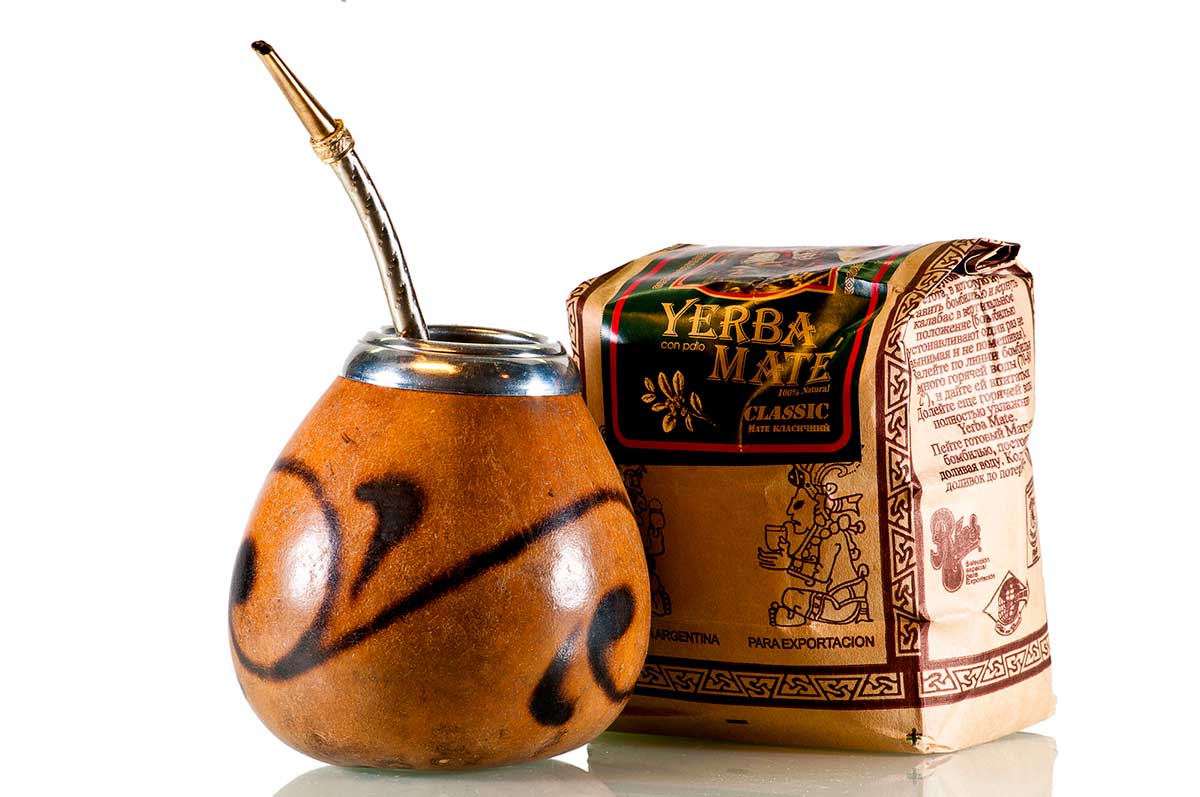
Fermented Tea
Fermented tea is a type of tea that’s been micro-fermented as part of the manufacturing process. The micro-fermentation takes place over a long time of several months or even several years. In China, these types of tea are called dark tea. They’re also known as post-fermented tea.
How Fermented Teas are Made
The teas often start with the same processing method as green tea or slightly oxidized oolong tea. Then the teas begin a microbial fermentation process in which they are pressed into bricks as part of the aging process. This process may be completed quickly within a few months or may continue for several years.
Where Fermented Teas Come From
Microfermented tea comes from China. You can also find types of fermented tea from Korea and Japan as well.
Health Benefits of Fermented Teas
There are many health benefits associated with drinking fermented teas. These benefits may include boosting your immune system and improving your digestion. YOu may find that you have more energy and fewer problems with inflammation.
Are Fermented Teas Caffinated?
Fermented teas have a high level of caffeine in them.
Types of Fermented Teas
- Awabancha
- Batabatacha
- Burmese Lahpet Tea
- Goishicha
- Japanese Tengu Kurocha
- Kombucha
- Korean Tteokcha
- Miang
- Sheng Pu-erh
- Shizuchikurocha
- Shu Pu-erh
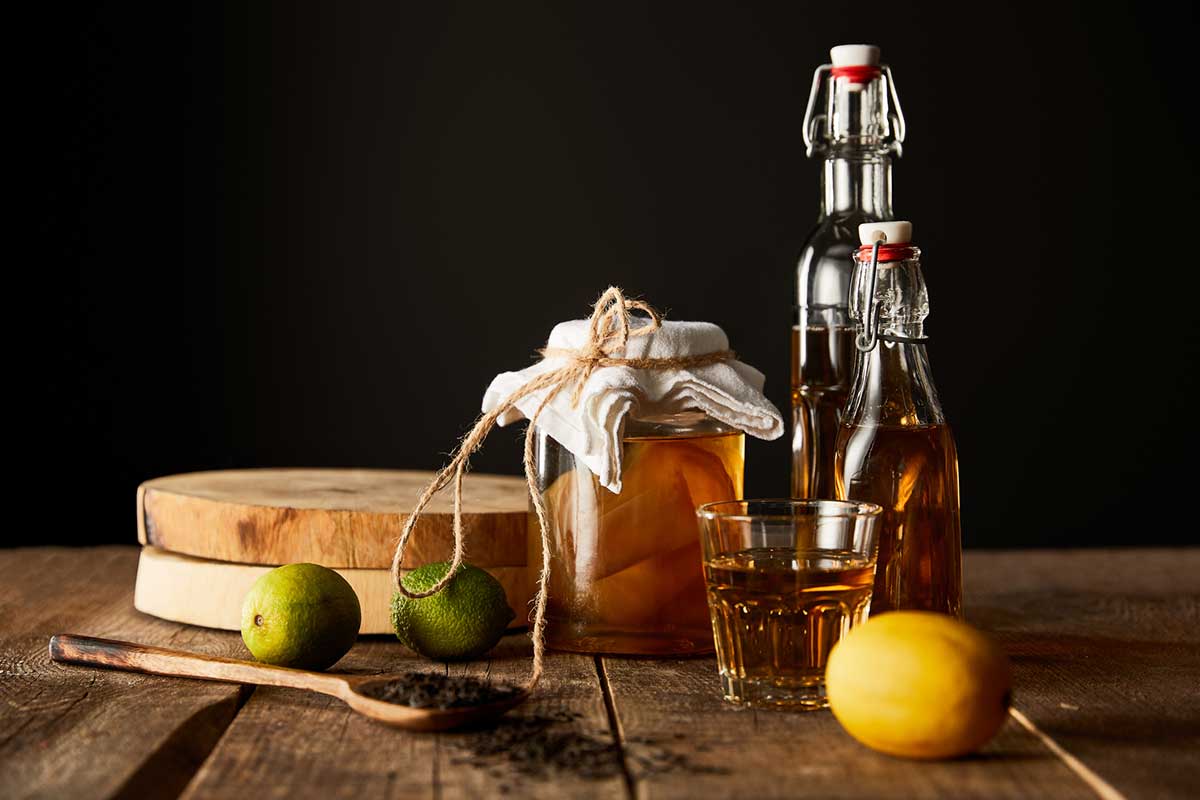
Herbal Tea
Herbal teas do not come from the tea plant. Instead, they are infusions or tisanes of herbs, spices, and other plants in hot water. Herbal teas have been used as medicine for thousands of years. For instance, there are many health benefits of oregano tea, and ginger tea is good for acid reflux.
Chamomile and lavender teas can help with insomnia. Several herbal teas fight inflammation.
How Herbal Tea is Made
Herbal tea is made by pouring hot water over a collection of fresh or dried flowers, twigs, leaves, seeds, or roots.
Where Herbal Tea Comes From
Herbal teas have been made worldwide throughout the years. The earliest known record was recorded in 2737 BC in China.
this will be a blanket statement since they all have different health benefits. Just talk about that and list some “for example” health benefits here.
Health Benefits of Herbal Tea
Since herbal teas come from a variety of different plants, they all have different health benefits.
For example, oregano tea has many health benefits, and chamomile tea may help you relax while reducing muscle spasms. Peppermint tea may help soothe an upset stomach, calm motion sickness, and help relieve headaches. Ginger tea helps acid reflux and may relieve with morning sickness and chronic indigestion.
Are Herbal Teas Caffinated?
No, the vast majority of herbal teas are not caffeinated.
Types of Herbal Tea
- Ashwagandha Tea
- Avocado Leaf Tea
- Bamboo Tea
- Buckwheat Tea
- Bush Tea
- Butterfly Pea Flower Tea
- Chaga Mushroom Tea
- Chamomile Tea
- Chrysanthemum Tea
- Coriander Seed Tea (Lots of health benefits of coriander seeds!)
- Dandelion Tea
- Echinacea Tea
- Elderberry Flower Tea
- Ginger Tea
- Gingko Tea
- Guayusa Tea
- Hibiscus Tea
- Honeybush Tea
- Honeysuckle Flower Tea
- Jasmine Tea
- Lavender Tea
- Lemon Balm Tea (lemon balm is also a type of microgreen with huge benefits!)
- Lemongrass Tea
- Licorice Tea
- Mamaki Tea
- Mint Tea
- Moringa Tea
- Olive Leaf Tea
- Passionflower Tea
- Peppermint Tea
- Red Raspberry Leaf Tea
- Rooibos Tea
- Rosehip Tea
- Rosemary Tea
- Sage Tea
- Stinging Nettle Tea
- Tulsi Tea
- Turmeric Tea
- Valerian Root Tea
- Yarrow Tea

Grain Tea
If you’re looking for a healthy alternative to true teas and coffee, you might consider drinking grain tea. Grain tea is an infusion made by soaking the grains in hot water. The main types of grain tea are barley, tartary buckwheat, Job’s tears, and corn silk.
Bubble Tea
Bubble tea is a drink that was created in Taiwan during the 1980s. It was originally made by dropping tapioca pearls into black tea. Now it comes in two varieties: with and without milk. The tapioca pearls are dropped into green, oolong, or black teas.
Bubble tea is a refreshing drink that’s enjoyed by people of all ages and is served in a wide variety of flavors.
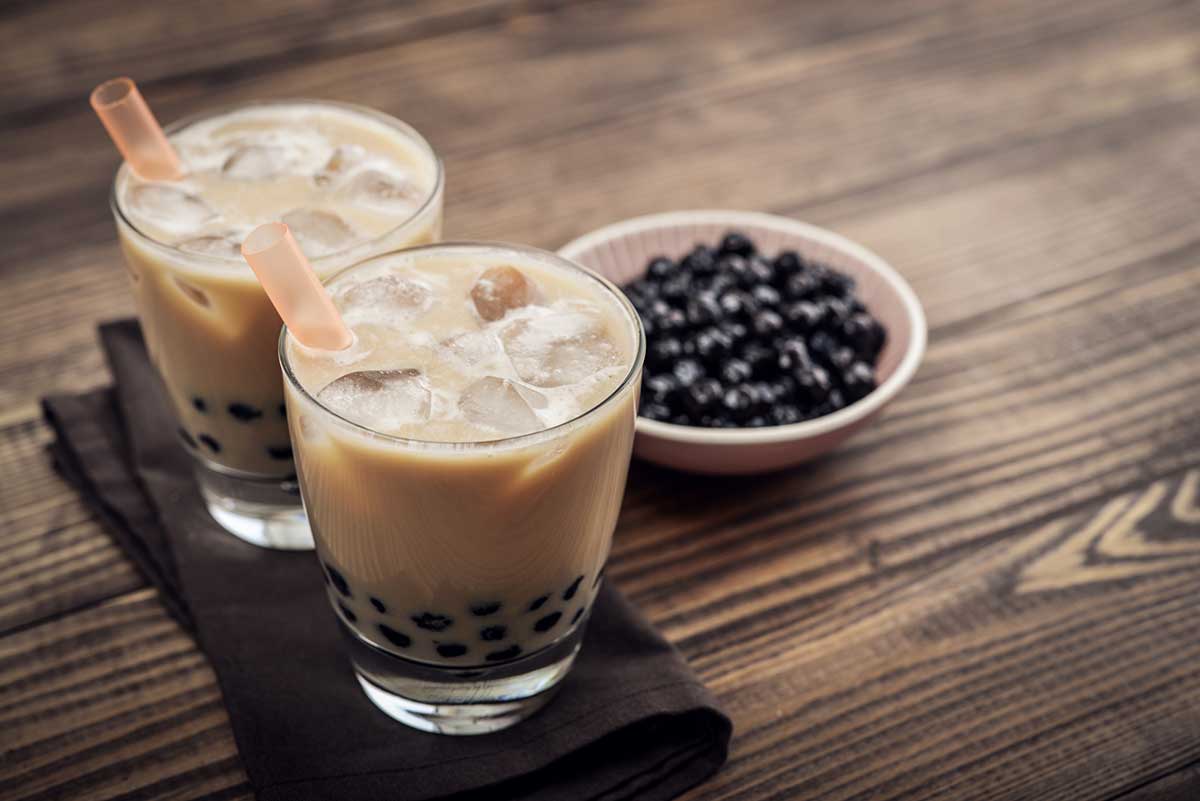
Loose Tea vs. Tea Bags
Most people begin drinking tea by using tea bags. Tea bags are filled with tea dust rather than tea leaves. As a general rule, tea bags don’t offer the depth of flavor that loose tea does.
It’s easy to make, though. You simply put a tea bag in your mug and pour hot water over it. Allow the tea bag to steep for a couple of minutes, and you have a flavorful cup of tea to enjoy.
Tea lovers prefer loose tea as it’s made from the entire tea leaf. This allows the tea to develop a wide depth of flavor to the tea as it steeps.
However, it’s slightly more difficult to prepare. You will need a teapot, infuser, or tea filter to hold the tea leaves as they steep.
How to Brew Tea
- The first step to brewing a delicious cup of tea is to bring water to a boil. Then pour the hot water over a tea bag in a cup or into a teapot filled with 1tsp of tea for every cup of water.
- The steep time for tea is between 1 and 5 minutes, depending on the type of tea. White and green teas only need to steep for a short time, while black, herbal, and pu’erh tea need to steep longer.
- Remove the tea bag or pour yourself a cup of tea.
You might also be interested in: Carrot Leaf Tea: Why You Should Drink It & How To Make It
Frequently Asked Questions About Tea
Do you have a few more questions about tea? Check out these frequently asked questions below to find your answers.
Does Tea Have More Caffeine than Coffee?
While different types of teas and coffee have varying levels of caffeine, tea usually has less caffeine than coffee.
Do herbal teas contain caffeine?
No, herbal teas do not contain caffeine.
Does Tea Expire?
Tea doesn’t have a true expiration date if it’s stored correctly. Instead, the tea loses strength and potency over time, resulting in a less flavorful cup.
What’s the Best Way to Store Tea?
You should store your tea leaf in an airtight, opaque container or in a dark cabinet. Teas should also be stored in a dry location in your kitchen to prevent humidity from damaging the leaves.
How Do You Ferment Tea?
Tea leaves are spread in withering troughs and exposed to air. The air oxidizes with the tea leaves and gives the tea its flavor. The different tea types are manufactured by changing the fermentation process.
Final Summary About Tea
The world of tea is full of different kinds of tea. Each tea has a different flavor profile. Some teas are drunk hot, while others are served as iced tea. No matter what type of tea you enjoy drinking, you’ll receive the health benefits of tea, like improved heart health and antioxidants.

